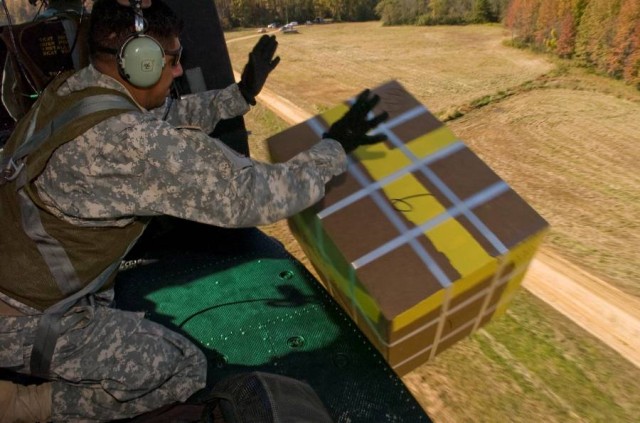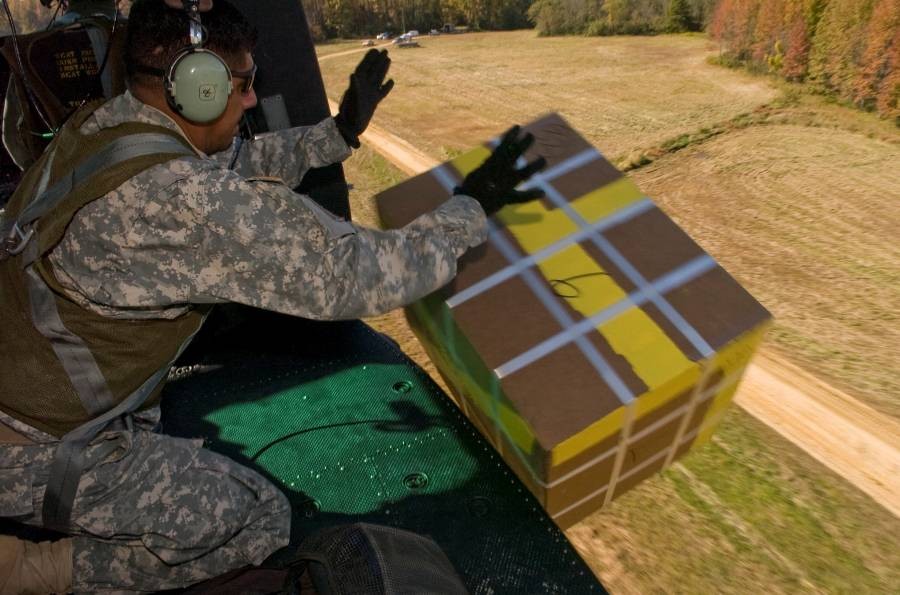
WASHINGTON (Army News Service, Feb. 23, 2010) -- The supply requirement in Afghanistan will dramatically increase this year according to the Army's top logistician, and he said the Army is testing a new airdrop system to help meet the demand.
Speaking at an Association of the U.S. Army Land Warfare Institute breakfast series Feb. 19, Lt. Gen. Mitchell H. Stevenson, Army G-4, told the attendees that he hopes the new delivery system will be ready for deployment to Afghanistan by the end of summer.
The Army Freedrop Packaging Concept Project is currently developing and testing a new airdrop system called the Freedrop Delivery System for Afghanistan.
The new system will allow bundles of supplies such as ammunition, small generators and other Class IX repair parts, Meals Ready to Eat, and bottled water of up to 150 pounds to be freedropped (no parachutes) at about 70 knots airspeed from under 75 feet above ground level at the current 19 Afghanistan outposts which can only receive supplies by air.
"The idea here was to develop a package that you just kick out the side of a helicopter or airplane when you're flying very low... 50 feet above ground," Stevenson said. "You eliminate the problem of packing, rigging the chute and of course doing any kind of recovery operation."
The freedrop system is currently being developed and tested by the Army G-4's Logistics Innovation Agency and involves a number of key stakeholders, to include operational partners in the 82nd Airborne Division at Fort Bragg, N.C.
The Army already uses four airdrop systems in Afghanistan. Getting supplies to Soldiers there is tough because the country has no seaport and relies on two main land routes so "airdrop has become big business" said the Army's chief logistician.
Back in 2008, the service dropped about 600 short tons of supplies into Afghanistan, Stevenson said. Last year that was upped to 15,000 short tons, he said.
"Now with the force increase, I expect that will go higher this year, so we're getting really, really good at airdrop," he said, noting that the logistics challenge covers an area the size of Texas.
One of the fielded systems, the Joint Precision Airdrop System, or JPADS, allows the Air Force to fly above the sand and surface-to-air missile threats, drop supplies from 5,000 to 25,000 feet. The packages then descend via parachute, directed by an autonomous guidance unit to the landing site.
"It works, but it has a couple of problems," Stevenson said. "The first problem is right now the JPADS sees in two dimensions, so it sees the spot on the ground, but it doesn't see mountains that might be in the way... so we've had some mishaps with JPADS right into the side of a mountain."
He said the new generation of JPADS coming out should fix that problem.
"The other problem is this guidance device on the parachute is not something we want to throw away... we've got to get it back," he said. If the drop hits the side of a mountain, Soldiers still need to retrieve the guidance system which defeats the purpose behind JPADS.
"It's a bit of a challenge, and the Soldiers don't like it as much as we thought they would, particularly in those hard-to-get-to places, but we'll continue to work that," Stevenson said.
Another airdrop system, which Stevenson said had been "very, very useful" is the Low-Cost Low-Altitude, or LCLA parachute system, that can be dropped from between 150-300 feet, but is a bit of a challenge for Air Force C-130s because some drop sites are tough to get in, turn and get out to avoid threats.
Over the last two years, LCLA parachutes have been well received and used effectively by forces in Afghanistan. The chutes are very accurate and are one-time use, which means that the retrograde of the parachutes is not necessary. Soldiers simply recover the supplies and move out on their missions.
The trucking side of supply will also increase in Afghanistan along with airdrop, Stevenson said. The plus-up of 30,000 additional troops in Afghanistan amounts to nearly a doubling of forces, he said.
"Up until about two years ago, we had about 30,000 or 35,000 forces there, the better part of a division-plus, which you could supply mostly by air," he said. "Nowadays, with the size of the force that we have and will have over the course of the rest of the year, you have got to get a lot more ground distribution and a lot more military truck companies, so we'll be doing that."

Social Sharing